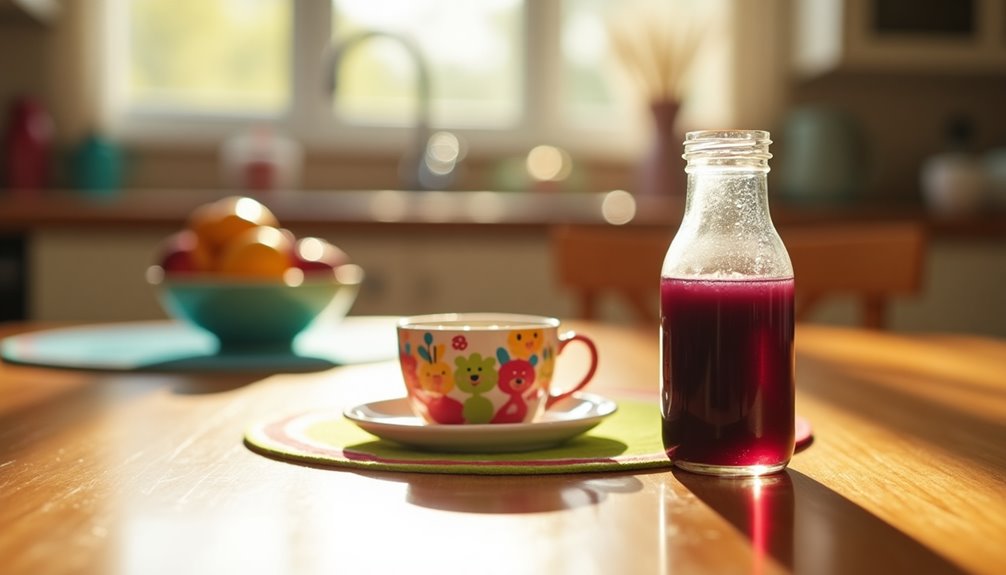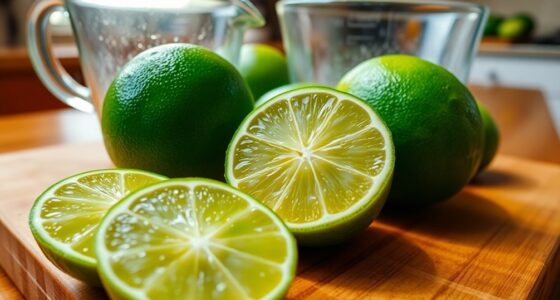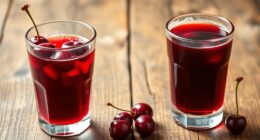For a 3-year-old, you should offer up to 4 ounces (118 ml) of prune juice a day to help with constipation. It's best to start with 1-2 ounces and see how your child reacts before gradually increasing the amount. Diluting the juice with water can make it easier for them to drink. A balanced diet with fiber-rich foods can also support healthy digestion. You might find more tips on how to introduce this remedy effectively.
Key Takeaways
- The recommended maximum dose of prune juice for a 3-year-old is 4 ounces (118 ml) per day.
- Start with a smaller amount, such as 1-2 ounces, to monitor your child's tolerance.
- Gradually increase the amount if the initial dosage is well tolerated.
- Diluting prune juice with equal parts water can make it easier for children to drink.
- Always consult a pediatrician before introducing prune juice or any new remedies.

When your 3-year-old is struggling with constipation, prune juice can be a helpful remedy. This natural laxative is often recommended due to its fiber content and ability to promote regular bowel movements. However, it's essential to understand how much prune juice is appropriate for your little one. The recommended maximum dose for a 3-year-old is about 4 ounces (118 ml) per day. This amount can help alleviate constipation without overwhelming your child's digestive system.
When introducing prune juice, it's wise to do so gradually. Start with a smaller amount, perhaps an ounce or two, and observe how your child responds. Some kids may experience adverse reactions, such as stomach irritation, if they consume too much too quickly. If your child seems to tolerate the juice well, you can slowly increase the amount up to the maximum recommended dose. Remember, moderation is key, and it's crucial to keep an eye on any signs of discomfort.
If your child finds the taste of prune juice too strong or if you want to minimize the risk of stomach upset, consider diluting the juice with water. Mixing equal parts prune juice and water can help reduce its concentration while still providing the laxative benefits you're looking for. This method can make it easier for your 3-year-old to drink and may encourage them to take it more willingly.
While prune juice is beneficial, it shouldn't be the only solution you rely on. A balanced diet rich in fiber is essential for maintaining regular bowel movements. Incorporate a variety of fruits, vegetables, and whole grains into your child's meals. Foods like apples, pears, broccoli, and oats can significantly aid in digestion and help prevent future constipation. The combination of fiber and prune juice can create a powerful duo in promoting healthy bowel habits.
Before introducing prune juice or any new remedy, it's always a good idea to consult your pediatrician. They'll provide guidance specific to your child's health needs, especially if there are any underlying health concerns. Your pediatrician may have additional recommendations or alternative solutions that could work better for your child.
Frequently Asked Questions
How Much Prune Juice Can I Give a 3 Year Old?
When considering how much prune juice to give your child, it’s important to start with small amounts. Gradually increase the quantity based on your child’s tolerance and reaction to the juice. If you’re unsure about how to serve prune juice toddlers, mixing it with water can help dilute the flavor and make it more palatable for young ones. Always monitor your child for any adverse reactions, and consult with a pediatrician if you have concerns.
You can introduce it gradually, aiming for less than 1 cup (8 ounces) per day. This helps avoid any stomach discomfort.
Keep an eye on how your child reacts and adjust accordingly.
It's also wise to consult your pediatrician before starting, especially if your child has never had prune juice or has health concerns.
How Quickly Does Prune Juice Work?
When you're looking for a gentle nudge for your little one's tummy troubles, prune juice can be your go-to solution.
It usually starts working within 12 to 24 hours, depending on how your child's digestive system responds. You'll likely see improvement in their comfort level in one to three days.
Just keep an eye on how they react, as everyone's tummy is a bit different, and moderation is key to avoid any discomfort.
How to Give Prunes to a 3 Year Old?
When you're giving prunes to a 3-year-old, start by offering them in small pieces or pureed.
You can also blend them into yogurt or applesauce for added flavor. If your child prefers, try serving them as a smoothie.
Always watch their reaction and adjust the amount accordingly.
Remember to balance prunes with regular meals, so your little one gets a well-rounded diet while supporting their digestive health effectively.
How Often Should a 3 Year Old Poop?
You might think your 3-year-old should be pooping like clockwork, but it's not always that simple!
Typically, kids this age have one to three bowel movements a day, though some may go days without a visit to the potty.
It all depends on their diet, hydration, and activity level.
Keep an eye on their stool's consistency, and if you're worried, don't hesitate to chat with a pediatrician for guidance!
Conclusion
So, you've found yourself wondering how much prune juice is just right for your 3-year-old. It's funny how these little questions pop up when you least expect them! Remember, a couple of ounces can work wonders, but every child's different. You'll likely discover the perfect amount through a bit of trial and error, just like you did when they first tried solid food. Trust your instincts, and soon, you'll be a prune juice pro!
Cindy thoroughly researches juicing trends, techniques, and recipes to provide readers with practical advice and inspiration. Her writing style is accessible, engaging, and designed to make complex concepts easy to understand. Cindy’s dedication to promoting the advantages of juicing shines through her work, empowering readers to make positive changes in their lives through the simple act of juicing.











